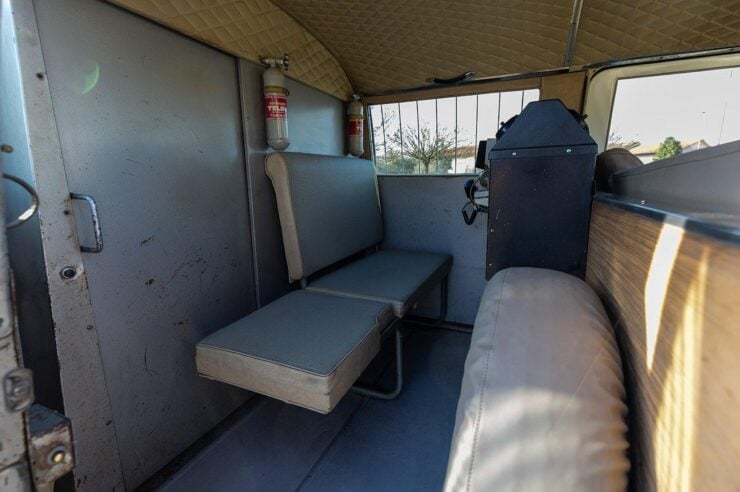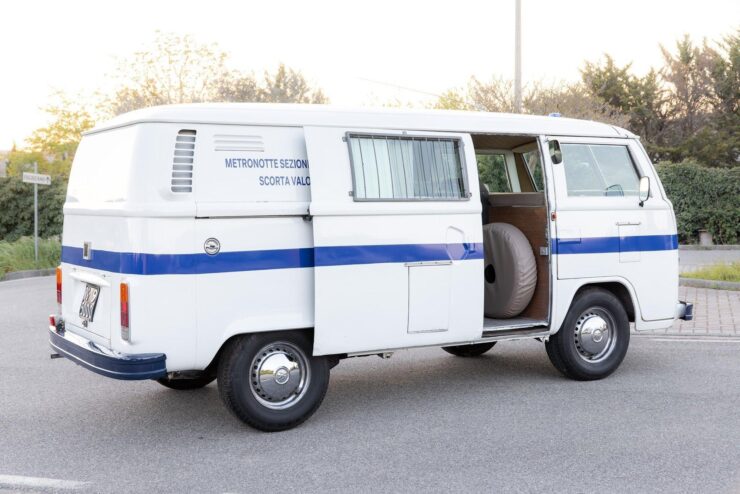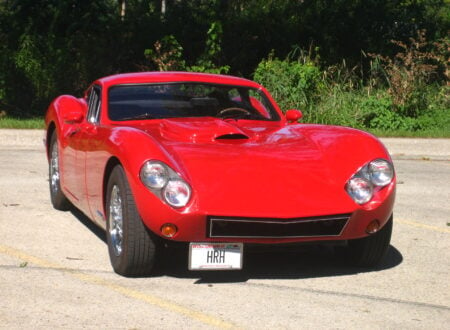This 1975 Volkswagen T2 left the factory in relatively standard van configuration, it was delivered to Italy where it was converted into an armored vehicle for use by Metronotte to transport jewelry, gold, and large sums of cash.
While the auction listing for this vehicle describes it as an armored personnel carrier it can probably be better described as an armored car. It’s been given plenty of armor and other protection for its role with Metronotte, and it’s now being offered for sale.
Fast Facts – A Volkswagen T2 Armored Personnel Carrier
- The Volkswagen T2 was developed as the successor to the original VW Bus, the T1. The T2 was introduced in the late 1960s, it featured significant design changes over its predecessor, most notably it was larger, and it was given a one-piece single panoramic windshield in place of the older two-piece design.
- The T2 retained the rear-engine, rear-wheel-drive layout of the T1 but offered improved performance and additional interior space. Early models were powered by the same air-cooled, horizontally opposed four-cylinder engines as the late T1 models, but later models were given more advanced (and more powerful) liquid-cooled engines.
- The T2 was manufactured not just in Germany but also in Brazil and Mexico, with each region introducing their own unique variants. The vans were used as campers, cargo haulers, people movers, and delivery vans – many of the camper van versions are still in use today.
- The VW T2 you see here is said to be one of just four ever made, it’s been modified into an armored vehicle for use transporting gold, jewels, and large sums of cash by Italian company Metronotte. It’s now being offered for sale out of Seine Maritime, France on Car & Classic.
From Plattenwagen To T2
There’s no way that anyone at Volkswagen could have known in 1950, then they first released the Type 2, that it would fundamentally revolutionize the world’s perception of what a van actually was. It became a staple for tradesmen around the world, it was the vehicle of choice for the hippie movement in the 1960s, and it became the most common camper van platform in the world.


The initial concept for the Volkswagen Type 2 came from a Dutch Volkswagen importer named Ben Pon. In 1947, Pon visited the Volkswagen factory in Wolfsburg, Germany.
While there, he noticed a unique, makeshift vehicle that the plant workers had created using a stripped-down Beetle chassis to transport parts and materials around the vast factory complex. This flatbed parts-mover, while rudimentary, was highly functional and sparked an idea in Pon’s mind.
Inspired by the flatbed vehicle he saw at the factory he sketched a design for a boxy, utilitarian vehicle built atop a Beetle chassis. His initial drawing, dated April 23, 1947, is often regarded as the first conceptualization of what would become the Type 2. Pon envisioned it as a multi-purpose vehicle that could serve as both a passenger and a cargo transporter.
Official production of the Volkswagen Type 2 commenced in March 1950 in Wolfsburg, Germany. It was called the Type 2 as it came after the VW Beetle, which was the Type 1.
The Type 2 had a number of different names in different regions, it was called the Transporter, Kombi or Microbus in the USA, the Bus or Kombi in Australia, the Camper in the UK, and the Bulli in Germany – however names were often mixed and matched between countries.
In 1967 the second generation of the Type 2 was introduced, it was internally called the T2 by Volkswagen, and the first generation model became the T1. The T2 featured a slew of upgrades over its predecessor including a new one-piece panoramic windscreen, it was wider, longer, more spacious, and more aerodynamic – the new shape quickly earned it the nickname “Breadloaf.”


Much like its predecessor, the T2 proved a best-seller and it was put to use in all the same roles. Camper versions remain wildly popular today and highly-collectible.
The Armored VW Type 2 Shown Here
The vehicle you see here is a Volkswagen T2 that is described as an armored personnel carrier in its auction listing, while it is armored and capable of carrying personnel, it was used as an armored car by Italian firm Metronotte.
Apparently four of these were made, the work carried out was relatively significant and it included the replacement of all original glass with thicker armored glass – creating a two-piece windscreen in the process. It appears as though additional steel plating has been installed internally, and the inside of the van remains fully equipped with all the elements used in its previous life hauling cash, gold, and valuables in Italy.
It’s difficult to know what this van’s future holds, and whether the new owner will keep it as it is now as a historic interest piece of convert it into something else – like the most secure camper van on earth.


It’s still powered by the original 1.6 liter VW flat-four which is mated to the standard 4-speed gearbox, so it’s likely not the fastest vehicle given the additional weight of the armor and thicker laminated glass.
It’s now being offered for sale out of Seine Maritime, France on Car & Classic with 93,669 kms on the odometer. If you’d like to read more about it or register to bid you can visit the listing here.









Images courtesy of Car & Classic








